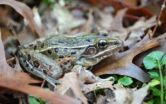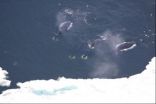(Press-News.org) Have you ever wondered how life is sustained in environments like deserts, deep seas or the polar regions? How do organisms adapt and thrive in such harsh conditions, and what challenges do they face as a result of human activities and climate change, especially climate "extremization"? Shedding light on some of these issues is the objective of the European Science Foundation's (ESF) session on 27 March at Planet Under Pressure 2012. The session will look at different aspects of life in extreme environments - from knowledge to sustainable exploitation of new resources under growing pressures. Recognizing the pivotal role of extreme environments at planetary level, the ESF-hosted session will be also endorsed by the International Geosphere-Biosphere Programme (IGBP) through the programme dedicated to land-atmosphere interactions (iLEAPS).
A selection of outstanding speakers from across Europe and the US will discuss emerging ideas about sustainable exploitation of novel resources, e.g. for food or non-food biotechnology, and fine-chemistry. The presentations will highlight research on biogeochemical cycles to understand the impacts of climate change and the ecosystem responses, and to provide knowledge about adaptation, land use change, and mitigation options.
This ESF-hosted session is a follow-up of the FP7-funded Coordinated Action for Research on Life in Extreme Environments (CAREX) project and strategic roadmap - a solid scientific consensus from a community of over 220 international experts studying life in every type of extreme environment - launched last year. CAREX's identified research priorities include life's response to climate and environmental change, its adaptation methods, understanding biodiversity and interactions within extreme environments, and finding limits of habitability which could inform the search for extraterrestrial life.
The ESF-hosted session will be split into four presentations:
Professor A. Altman, from the Hebrew University of Jerusalem in Israel, will shed light on the desert environments, highlighting plant-specific coping molecular and physiological mechanisms based on chaperone proteins that superintend the general metabolism under harsh environments
Dr D.S.M. Billet, from the National Oceanography Centre Southampton in the UK, will present an overview of mining in the deep sea and the issues surrounding protection of marine life
Dr C. Verde, from the Institute of Protein Biochemistry at the National Research Council in Italy, will report on Antarctic bacterial globins and their role in nitric oxide (NO) biology, highlighting how this and other findings may be exploited for sustainable exploitation of biological resources in extreme environments
Dr L.J. Rothschild, from the NASA Ames Research Center in the US, will focus on life in extreme environments from NASA's perspective
ESF's session is an opportunity for Planet Under Pressure's delegates to gain new perspectives on the latest research into life in extreme environments, to interact with leading scientists in the field, and to gain a real understanding of the pro-active role of CAREX so far, and its vision about future sustainable exploitation of life resources in the extreme environments.
ESF will be also hosting a side meeting, attendance by invitation only, on 27 March, on research on life in extreme environments, taking a retrospective look and an outlook at pressures on our planet and global change. Research on life in extreme environments provides outstanding opportunities to advance our fundamental scientific knowledge of the variety of life processes. It is also relevant to current societal challenges such as technological innovation, exploitation of novel compounds, advance knowledge on impacts of global change on biodiversity, and sustainable exploitation of resources, in turn alleviating pressures on our planet. To be properly and efficiently addressed, such an interdisciplinary area of knowledge (ranging from deep sea to polar regions to alpine ecology to astrobiology) requires the definition, coordination, and implementation of a holistic plan and policy in the future.
The outcome of this side meeting will see the publication of a vision paper on the scientific challenges and societal opportunities offered by research on life in extreme environments, as well as policy implications.
###
For further information please contact:
Tom Reast, Consultant, Kaizo pr & digital communications
tom.reast[at]kaizo.co.uk | Tel: +44 (0) 20 3176 4721
Nicolas Walter, European Science Foundation
nwalter [at]esf.org, | Tel: +33 (0)388 767166
CAREX (Coordination Action for Research Activities on life in Extreme Environments) was a Coordination Action supported by the European Commission Seventh Framework Programme (FP7) under contract no. 211700. www.carex-eu.org/
The European Science Foundation (ESF) was established in 1974 to provide a common platform for its Member Organisations to advance European research collaboration and explore new directions for research. It is an independent organisation, owned by 72 Member Organisations, which are research funding organisations, research performing organisations and academies from 30 countries. ESF promotes collaboration in research itself, in funding of research and in science policy activities at the European level. www.esf.org
END
Montreal, March 16, 2012 – A clinical study co-led by the Montreal Heart Institute and Innovaderm Research Inc., which was presented today at the annual meeting of the American Academy of Dermatology, shows that a new treatment for psoriasis could be associated with a significant decrease in vascular inflammation, a major risk factor of cardiovascular disease.
Psoriasis is a chronic inflammatory disease of the skin and joints that affects up to 3% of the population. This disease is associated with a greater risk of heart attack (infarction) and stroke. The goal of this ...
Early snowmelt caused by climate change in the Colorado Rocky Mountains snowballs into two chains of events: a decrease in the number of flowers, which, in turn, decreases available nectar. The result is decline in a population of the Mormon Fritillary butterfly, Speyeria mormonia.
Using long-term data on date of snowmelt, butterfly population sizes and flower numbers at the Rocky Mountain Biological Laboratory, Carol Boggs, a biologist at Stanford University, and colleagues uncovered multiple effects of early snowmelt on the growth rate of an insect population.
"Predicting ...
In the wilds of New York City--or as wild as you can get that close to skyscrapers--scientists have found a new leopard frog species.
For years, biologists mistook it for a more widespread variety of leopard frog.
While biologists regularly discover new species in remote rainforests, finding this one in ponds and marshes--sometimes within view of the Statue of Liberty--is a big surprise, said scientists from the University of California, Los Angeles; Rutgers University; the University of California, Davis and the University of Alabama.
"For a new species to go unrecognized ...
You've been feeling under the weather. You Google your symptoms. A half-hour later, you're convinced it's nothing serious—or afraid you have cancer. More than 60 percent of Americans get their health information online, and a majority of those decide whether to see a doctor based on what they find. "Wow, this is an era of self-diagnosis," thought Arizona State University psychologist Virginia Kwan, learning that statistic. How might information accessed online affect individual health decisions?
In a new study, Kwan and her colleagues found that the way information is ...
TORONTO, ON—Scientists at the University of Toronto have found a molecular mechanism that plays a key role in the transition of Candida albicans yeast into disease-causing fungus—one of the leading causes of hospital-acquired infection. The finding highlights the importance of heat in fungal growth, and provides a new target for drug therapies to counter Candida albicans infection.
Candida albicans is a normally harmless yeast that is present in all humans. It becomes infectious in various genetic and environmental conditions, with temperature as a key determinant. It ...
NEW YORK (March 16, 2012)—A rapid increase in shipping in the formerly ice-choked waterways of the Arctic poses a significant increase in risk to the region's marine mammals and the local communities that rely on them for food security and cultural identity, according to an Alaska Native groups and the Wildlife Conservation Society who convened at a recent workshop.
The workshop—which ran from March 12-14—examined the potential impacts to the region's wildlife and highlighted priorities for future management of shipping in the region. The meeting included participants ...
Glacial meltwater increases biodiversity in mountainous freshwater ecosystems. As glaciers vanish due to global warming, so will those species dependent upon the icy runoff. This is the conclusion of a study authored by researchers from, among other institutions, the University of Copenhagen.
The article "Glacial river biodiversity" with the alarming new findings can be found in the journal Nature Climate Change.
"The knowledge is new and startling. Glacial runoff is cold, nutrient-poor and physically unstable, and therefore, typically species-poor. Traditionally, we ...
Researchers from Clemson University have found a way to create temporary holes in the membranes of live cells using a standard inkjet printer. The method will be published in JoVE, the Journal of Visualized Experiments, on March 16.
"We first had the idea for this method when we wanted to be able to visualize changes in the cytoskeleton arrangement due to applied forces on cells," said paper-author Dr. Delphine Dean.
She said other researchers have been using this method to print cells onto slides, but that they have only recently discovered that printing the cells ...
The study's objective was to identify which skills and competencies are considered most critical for primary care providers (PCPs) to learn in order to effectively manage opioid risk in patients treated for chronic pain
Study participants included experts in primary care, pain management, and addiction
Experts in this study identified the most important skills for PCPs managing opioid risk in chronic pain patients as how to monitor opioids and how to assess for risk factors
Primary care physicians are faced with treating a large proportion of chronic pain patients, ...
The European Union's Habitats Directive is now 20 years old, and its network of protected areas, known as Natura 2000, is nearing completion. After a slow start, the network now includes some 26 000 protected sites and covers approximately 18% of the EU's land surface as well as significant areas of sea. It is widely considered to be the world's largest network of protected areas based on agreed site selection criteria. The review has been published in the newly launched open-access journal Nature Conservation.
Douglas Evans, seconded to the Paris-based European Topic ...




